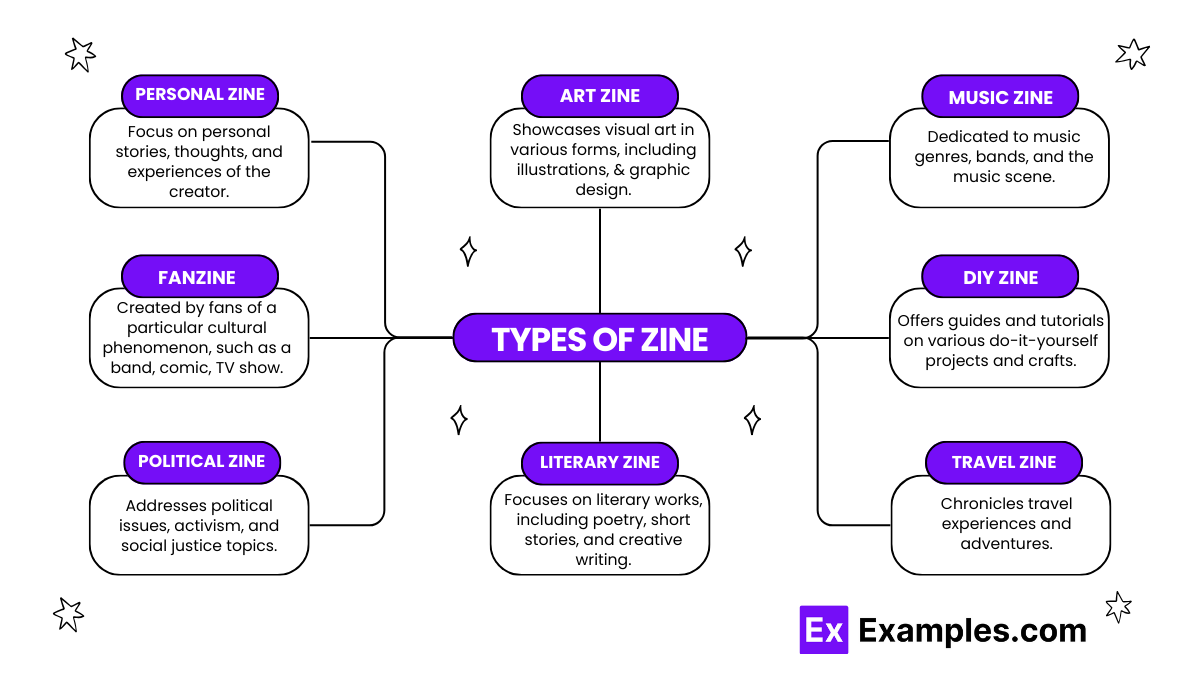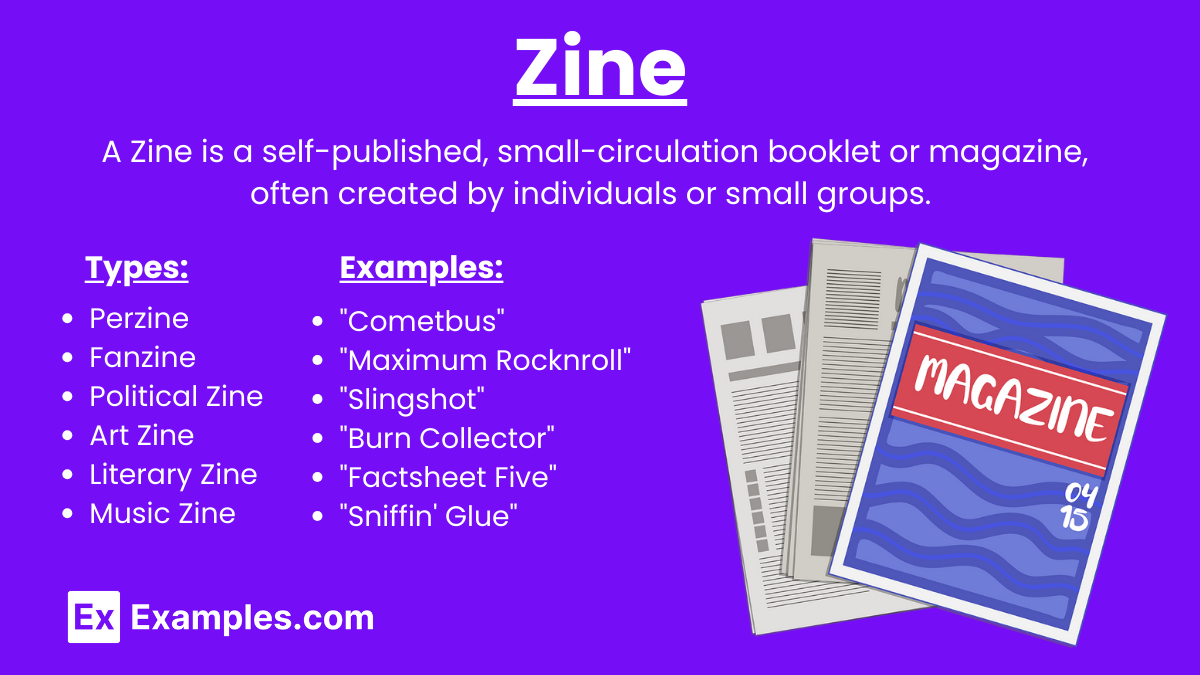20+ Zine Examples to Download
A zine is a small-circulation, self-published work of original or appropriated texts and images, usually reproduced via photocopier. Zines are often created by individuals or small groups and are typically associated with a particular subculture, topic, or community interest. Creating zines can involve significant group communication, as they often reflect collaborative efforts and shared ideas. Effective group communication skills are essential when working on zines, especially when coordinating contributions and ensuring that all voices are heard. Additionally, understanding oral communication in small groups can enhance the collaborative process. Zines can also serve as a platform for expressing the unique perspectives of an ethnic group, highlighting cultural narratives, issues, and experiences that may not be represented in mainstream media.
What is Zine?
A zine is a self-published, small-circulation booklet or magazine, often created by individuals or small groups. Zines are typically produced using simple, low-cost methods like photocopying or printing, and they cover a wide range of topics, including art, music, culture, politics, and personal stories. These publications are known for their DIY (do-it-yourself) aesthetic and are often distributed by hand, through mail, or at local events and independent bookstores.
Examples of Zine
- “Cometbus”
- “Maximum Rocknroll”
- “Slingshot”
- “Burn Collector”
- “Factsheet Five”
- “Sniffin’ Glue”
- “Doris”
- “Found”
- “Clamor”
- “Zine World”
- “Riot Grrrl”
- “Broken Pencil”
- “The Match!”
- “Fat City Review”
- “Giant Robot”
- “Processed World”
- “Ladybeard”
- “Xerography Debt”
- “Fluke”
- “Punk Planet”
Types of Zine

1. Personal Zine (Perzine)
- Description: Focus on personal stories, thoughts, and experiences of the creator.
- Content: Autobiographical narratives, diary entries, personal essays, and reflections.
2. Fanzine
- Description: Created by fans of a particular cultural phenomenon, such as a band, comic, or TV show.
- Content: Reviews, fan fiction, interviews, and artwork related to the subject of interest.
3. Political Zine
- Description: Addresses political issues, activism, and social justice topics.
- Content: Essays, manifestos, informational articles, and calls to action.
4. Art Zine
- Description: Showcases visual art in various forms, including illustrations, photography, and graphic design.
- Content: Artworks, artist statements, and creative layouts.
5. Literary Zine
- Description: Focuses on literary works, including poetry, short stories, and creative writing.
- Content: Original written works, literary critiques, and writing prompts.
6. Music Zine
- Description: Dedicated to music genres, bands, and the music scene.
- Content: Album reviews, concert reports, band interviews, and music-related essays.
7. DIY Zine
- Description: Offers guides and tutorials on various do-it-yourself projects and crafts.
- Content: Step-by-step instructions, photos of completed projects, and tips for crafting.
8. Travel Zine
- Description: Chronicles travel experiences and adventures.
- Content: Travel stories, destination guides, travel tips, and photographs.
Purpose of a Zine
- Self-Expression: Allow individuals to share personal thoughts, ideas, and creativity.
- Community Building: Connect people with similar interests, fostering a sense of community.
- Alternative Media: Offer perspectives and content not typically found in mainstream media.
- Advocacy and Activism: Raise awareness and promote social, political, and environmental causes.
- Education and Information Sharing: Provide knowledge and insights on diverse topics through guides and tutorials.
- Creative Outlet: Enable creators to explore and showcase their artistic talents.
- Preservation of Subcultures: Document and maintain the history and culture of niche communities.
- DIY Ethic: Promote self-publishing and independent production, embracing a handmade aesthetic.
Zine Ideas
Zines offer a versatile platform for creative expression and information sharing. Here are some popular zine ideas:
- Personal Memoir: Share life stories and reflections through autobiographical essays and diary entries.
- Travel Zine: Chronicle travel adventures with stories, destination guides, and travel tips.
- Art and Photography: Showcase artwork and photography, including sketches, paintings, and photo series.
- Fiction and Poetry: Publish creative writing, such as short stories and poems.
- Music Zine: Focus on music genres, bands, and the music scene with reviews and interviews.
- DIY and Crafts: Provide tutorials and ideas for DIY projects and crafts.
- Food and Recipes: Share culinary creations with recipes, cooking tips, and food photography.
- Political and Social Issues: Address important political and social topics with essays and informational articles.
- Cultural Commentary: Explore and critique cultural and societal aspects through opinion pieces and satire.
- Health and Wellness: Promote well-being with self-care tips, wellness practices, and fitness routines.
- Science and Nature: Discuss scientific topics and natural phenomena with articles and research summaries.
Uses of Zine
- Creative Expression: Zines provide a platform for individuals to express their creativity, share personal stories, art, poetry, and photography. They allow creators to experiment with different styles and formats, free from the constraints of mainstream publishing.
- Community Building: Zines foster a sense of community among like-minded individuals. They are often distributed within subcultures or interest groups, helping to build connections and share ideas among members of those communities.
- Advocacy and Activism: Zines are powerful tools for advocacy and activism. They are used to raise awareness about social, political, and environmental issues, providing a voice for marginalized communities and promoting social change.
- Education and Information Sharing: Zines can be educational, sharing knowledge on a variety of subjects such as DIY projects, health, history, and culture. They provide an alternative source of information that is often more accessible and relatable than traditional media.
- Personal Journals: Many zines function as personal journals, where creators document their thoughts, experiences, and reflections. This form of self-expression can be therapeutic and helps to connect with readers on a personal level.
- Art and Design Showcases: Artists and designers use zines to showcase their work, creating portfolios that highlight their unique styles and projects. This helps them gain exposure and reach potential clients or collaborators.
- Literary Outlets: Writers use zines to publish their poetry, short stories, essays, and other literary works. Zines provide a space for writers to share their voices and reach an audience without the need for traditional publishing channels.
- Music and Culture Promotion: Music fans and enthusiasts create zines to promote bands, review albums, and discuss music scenes. These zines often include interviews, concert reviews, and other content that supports and celebrates musical culture.
What topics do zines cover?
Zines can cover any topic, including music, politics, art, personal experiences, and subcultures.
Why are zines important?
Zines offer a platform for marginalized voices, promote creativity, and foster independent publishing outside mainstream media.
How are zines different from magazines?
Zines are typically handmade, self-published, and have a smaller circulation, while magazines are professionally produced and widely distributed.
What materials do you need to make a zine?
You need paper, pens, markers, scissors, glue, and access to a copier or printer to make a zine.
Can zines be digital?
Yes, zines can be digital, distributed as PDFs, or viewed online, but many creators prefer the tactile experience of physical copies.
How do you distribute a zine?
Distribute zines at events, through mail order, in local shops, or by trading with other zine creators.
What is the zine community?
The zine community is a network of creators, readers, and collectors who share a passion for independent publishing and DIY culture.
Why create a zine?
Create a zine to share your ideas, connect with like-minded people, and enjoy the freedom of self-expression without commercial constraints.
What is a perzine?
A perzine, or personal zine, focuses on the creator’s personal experiences, thoughts, and feelings.
How do you start a zine?
Start a zine by choosing a topic, planning your content, gathering materials, and creating your pages. Then, copy and distribute your zine.



